
a web page by Don Roberson |
IFRITA Ifritidae |
|
|
 |
This now all seems wrong. Norman et al. (2009) found Ifrita to be to in a clade containing two monarch genera, Monarcha and Myiagra. Jønsson et al. (2011) sequenced DNA for a wide variety of corvoid birds. They found that Blue-capped Ifrita was a very early offshoot in the corvoid tree on the lineage that led to monarchs. Based upon this finding, it could be included as the basal member of the monarchs (family Monarchidae). However, its ancient lineage could also support separate family status. Schodde & Christidis (2014) proposed full Family status for this unique species. The proposal was supported by further molecular evidence, using 8 nuclear and 4 mitochondrial loci, in Jønsson et al. (2016), who placed this family between monarchs and cuckoo-shrikes. With these new publications, it seems likely that most world checklists will adopt the Ifritidae as a single-species family. |
Ifrita is very unlike the birds with which it had earlier been aligned. It is a chunky brownish bird with a bright blue crown, a relatively short tail, and creeper-like habits; Coates (1990). It does not walk on the ground or act like anything in the quail-thrushes, jewel-babbler, whipbird, or rail-babbler families. Rather, Blue-capped Ifrita forages nuthatch-like on trunks and branches, in mossy cloud forest, and ranges from fallen logs or the upper canopy. It probes and digs in the moss for prey, and can forage on the undersides of limbs. It feeds mostly on insects, but small fruit is sometimes consumed. Its standard vocalization is a sharp three-note call jit-jit-jit. Two songs have been described, including a loud exuberant musical song with "squeeze toy" elements (Beehler et al. 1986). In my own brief experience with the species in Papua New Guinea, it did recall a nuthatch as it rooted around in mossy branches at or above eye-level at the edge of a wet cloud forest. |
 |
Photos: Hideo Tani photographed the Blue-capped Ifrita Ifrita kowaldi above Ambua Lodge, Tari, Papua New Guinea, in January 2003. My own photos were in that same locale — cloud forest above Ambua Lodge near Tari Gap — on 7 Sep 2016. Photos © Don Roberson and © Hideo Tani, as credited, and used with permission; all rights reserved. Bibliographic note: There is no "family book" on this new family, but a good introduction to the genus, with photos, is in Boles (2007). Literature cited:
|
 Blue-capped Ifrita
is an unusual passerine of montane rain-forests in New Guinea (left, a
photo by Hideo Tani, and below, my own shot). It has traditionally been
aligned with whipbirds, quail-thrushes, jewel-babblers (e.g., Sibley
& Monroe 199), but these have since been shown to be in different
families. At one point the Rail-babbler of southeast Asia was included
in the melange, and the family called Eupetidae. Handbook of the Birds of the World was published in that era (Boles 2007) and put Ifrita there. When
Blue-capped Ifrita
is an unusual passerine of montane rain-forests in New Guinea (left, a
photo by Hideo Tani, and below, my own shot). It has traditionally been
aligned with whipbirds, quail-thrushes, jewel-babblers (e.g., Sibley
& Monroe 199), but these have since been shown to be in different
families. At one point the Rail-babbler of southeast Asia was included
in the melange, and the family called Eupetidae. Handbook of the Birds of the World was published in that era (Boles 2007) and put Ifrita there. When